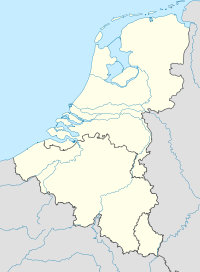
Back Benelux Afrikaans Benelux ALS بنلوكس Arabic Benelux AST Benilüks Azerbaijani Бенилюкс Bashkir Бенілюкс Byelorussian Бэнілюкс BE-X-OLD Бенелюкс Bulgarian বেনেলাক্স ইউনিয়ন Bengali/Bangla
Benelux Union | |
|---|---|
 | |
Member states of the Benelux Union
| |
| Administrative centre and largest agglomeration | Brussels 50°51′N 4°21′E / 50.850°N 4.350°E |
| Official languages | |
| Type | Politico-economic union |
| Member states | |
| Legislature | Parliament |
| Establishment | |
• Customs union treaty signed | 5 September 1944[2] |
• Customs union in effect | 1 January 1948[2] |
• Renewal signed | 17 June 2008 |
• Renewal in effect | 1 January 2010 |
| Area | |
• Total | 75,140[3][4][5] km2 (29,010 sq mi) |
| Population | |
• Density | 405/km2 (1,048.9/sq mi) |
| GDP (nominal) | 2021 estimate |
• Total | |
• Per capita | |
| Currency | Euro (EUR) |
| Time zone | UTC+1 (CET) |
• Summer (DST) | UTC+2 (CEST) |
| Drives on | Right |
Website benelux | |
The Benelux Union (Dutch: Benelux Unie;[8] French: Union Benelux;[9] Luxembourgish: Benelux-Unioun)[10] or Benelux is a politico-economic union and formal international intergovernmental cooperation of three neighbouring states in Western Europe: Belgium, the Netherlands, and Luxembourg.[11] The name is a portmanteau formed from joining the first few letters of each country's name and was first used to name the customs agreement that initiated the union (signed in 1944).[12] It is now used more generally to refer to the geographic, economic, and cultural grouping of the three countries.
The Benelux is an economically dynamic and densely populated region, with 5.6% of the European population (29.55 million residents) and 7.9% of the joint EU GDP (€36,000/resident) on 1.7% of the whole surface of the EU.[13] In 2015, 37% of the total number of EU cross-border workers worked in the Benelux;[14] 35,000 Belgian citizens work in Luxembourg, while 37,000 Belgian citizens cross the border to work in the Netherlands each day. In addition, 12,000 Dutch and close to a thousand Luxembourg residents work in Belgium.[15]
The main institutions of the Union are the Committee of Ministers, the Council of the Union, the General Secretariat, the Interparliamentary Consultative Council and the Benelux Court of Justice while the Benelux Office for Intellectual Property covers the same land but is not part of the Benelux Union.
The Benelux General Secretariat is located in Brussels. It is the central platform of the Benelux Union cooperation. It handles the secretariat of the Committee of Ministers, the Council of Benelux Union and the sundry committees and working parties. The General Secretariat provides day-to-day support for the Benelux cooperation on the substantive, procedural, diplomatic and logistical levels. The Secretary-General is Frans Weekers from the Netherlands and there are two deputies: Deputy Secretary-General Michel-Etienne Tilemans from Belgium and Deputy Secretary-General Jean-Claude Meyer from Luxembourg.
The presidency of the Benelux is held in turn by the three countries for a period of one year. Belgium holds the presidency for 2024.
About 80 percent of the Benelux population speaks Dutch, about 20 percent speaks French and one percent Luxembourgish as their native language. A small minority under one percent are native German speakers.
- ^ "Révision portant sur le traité de 1958" (PDF) (in French). 2008.
Article 38 : le français et le néerlandais sont les langues officielles des institutions de l'Union Benelux
- ^ a b Peaslee, Amos Jenkins; Xydis, Dorothy Peaslee (1974). International governmental organizations. BRILL. p. 165. ISBN 978-90-247-1601-2. Retrieved 4 September 2011.
- ^ a b "Bevolkingsteller". Statistics Netherlands (in Dutch). Retrieved 9 June 2021.
- ^ a b "Structure of the Population". Statbel. Retrieved 10 September 2024.
- ^ "Statistiques // Luxembourg". statistiques.public.lu. 10 September 2024. Retrieved 10 September 2024.
- ^ "Statistiques // Luxembourg". statistiques.public.lu. 10 September 2024. Retrieved 10 September 2024.
- ^ "Gross domestic product at market prices (Current prices and per capita)". Eurostat.
- ^ "Over de Benelux" (in Dutch). Benelux. Archived from the original on 13 January 2015. Retrieved 9 February 2015.
Dit alles onder een nieuwe naam: de Benelux Unie.
- ^ "A propos du Benelux" (in French). Benelux. Retrieved 9 February 2015.
Le 17 juin 2008, un nouveau Traité Benelux était signé. Désormais, la coopération va se concentrer sur trois thèmes-clés: le marché intérieur & l'union économique, le développement durable et la justice & les affaires intérieures et tout ceci sous un nouveau nom: l'Union Benelux.
- ^ "De Benelux" (in Luxembourgish). Government of Luxembourg. 4 January 2018. Retrieved 21 October 2018.
D'Benelux-Unioun besteet aus dem Kinnekräich Belsch, dem hollännesche Kinnekräich an dem Groussherzogtum Lëtzebuerg.
- ^ "Benelux Treaty of Economic Union - Belgium-Luxembourg-Netherlands [1958]".
- ^ Revue de l'Institut International de Statistique (1947) Vol. 15, No. 1/4, page 43. However, according to The Economist, it was coined in August 1946 by that newspaper's correspondent in Belgium ("Going Dutch". The Economist. 3 May 2008. Retrieved 6 September 2012.).
- ^ "Facts and figures, EU demographics | European Union". european-union.europa.eu. Archived from the original on 20 November 2023. Retrieved 5 April 2024.
- ^ "Benelux Summit Jount Declaration 2015 - A Benelux Action Plan for jobs and growth" (PDF). Brussels. 29 April 2015. Archived (PDF) from the original on 5 April 2024.
- ^ "Benelux | Definition, Countries, History, & Facts". Encyclopædia Britannica. Retrieved 28 June 2024.

